Images Of Poliomyelitis
Flu in Denver, Year
2003
Toxicological Considerations
by Jim West
[This page is a work in progress, an inquiry, until at least April, 2004.
Feedback welcome.]
Theoretical Position
This paper
outlines hypotheses regarding the position that total stress burden
upon an individual is a cause for influenza.
Stress As Causation
Cold weather,
stressing the respiratory system, can bring on flu symptoms. Psycho-social stress
can contribute, as when the
chessmaster, Boris Spasky suffered a lengthy bout of flu after losing to
Bobby Fischer. Similarly, social loss (of a close friend or
relative) brings about the same
symptoms.
Stress can be emotional, social, innate, due to internally absorbed
pharmaceutical poisons, pesticides in food, and externally absorbed industrial
poisons, such as emissions and pesticides.
Industrial pollution is an
established factor in
disease causation, at the least, in orthodox terms, when immunity is weakened due to the stress of pollution.
Environmental Toxicology and Flu-Like Diseases
"Confirmed (by lab tests) viral upper respiratory influenza" is just one of many
similar diseases that occur before, during and after the flu season.
Yet, all of these similar diseases may have a common cause, ie., stress from
air pollution.
1) Chemical labels often warn of symptoms of over-exposure in terms of
"flu-like illness."
2) West Nile virus disease is described as "flu-like illness",
which incidence correlates day-to-day with air emission levels and
topography: www.geocities.com/noxot
3) Polio symptoms (early stage) are flu-like, and this disease correlates
well with persistent pesticide exposure: www.geocities.com/harpub
4) SARS is a "flu-like illness", with its incidence correlating
well with air pollution levels and topography:
www.westonaprice.org/envtoxins/sarsepidemic.html
No
human or animal is being diagnosed with "air pollution" disease,
even though it is agreed within orthodoxy that air pollution is a major
killer, greater than automobile accidents. So how is air pollution
disease being diagnosed?
Colorado, Winter 2003
This year, 2003, Colorado seems to be getting the most news re flu
epidemics. Several children have died, and over 6,000 stricken to
date (12/14/2003).
These epidemics correlate perfectly with air pollution. Here is a
description of winter pollution:
http://www.raqc.org/winter/winter-act.htm
"Denver's Winter High Pollution Season"
"Strong temperature inversions can lead to increased carbon monoxide (CO)
and
particulate matter (PM) levels and impaired visual air quality in the
region
during the winter months, jeopardizing our health and our economy."
This gets the picture across quickly:
 |
| "An unwelcome guest, Denver's "brown
cloud" of smoke and smog returns to the city each winter as
heavy, cold air holds pollutants close to the ground. The cloud's
dismal color is created by sunlight reflected off dustlike particles
of wood smoke, diesel exhaust, and factory emissions. From
mid-November to mid-January, when atmospheric inversions often occur
here, Denver also suffers the nation's highest concentration of
carbon monoxide." [Adjacent oil refineries are not mentioned
nor viewed in this URL
page.] |
|
www.geocities.com/CapitolHill/Lobby/2554/ng-air9.htm |
Another descriptive item
http://boston.bizjournals.com/denver/stories/2003/11/03/focus2.html
"City's industrial landscape getting makeover
Erin Johansen
Denver Business Journal
Denver's northeast neighbor, Commerce City, is closely associated with heavy industry, including the
oil refineries that
dominate the landscape."
A Colorado State study (year 2001) finds,
"Formaldehyde risk is about 100
times above the EPA-recommended level. Acetaldehyde risk is about 10
times the EPA-recommended level."
There is much evidence that
formaldehyde from petrochemical sources (MTBE) was a primary cause for the
flu epidemics called "West
Nile virus epidemics" in the U.S. See www.geocities.com/noxot
Colorado
State's study concluded, "Many of the compounds measured do not have
EPA-recommended toxicity 'benchmarks'. Of those that do,
formaldehyde, acetaldehyde, 1,3-butadiene, benzene, carbon tetrachloride,
tetrachloroethylene, and p-dichlorobenzene are present in Denver air at
levels that may create health concerns." -- UrbanAirToxicsFinal.pdf,
prepared by Air Pollution Control Division, Technical Services, State of
Colorado.
The study does not mention "refinery" in its executive
summary, however, the word is otherwise found frequently throughout.
The
study provides a full-year (2000-2001, not 2003) graph of levels of formaldehyde and similar
compounds. My annotations of the two forms of
influenza disease are in blue:
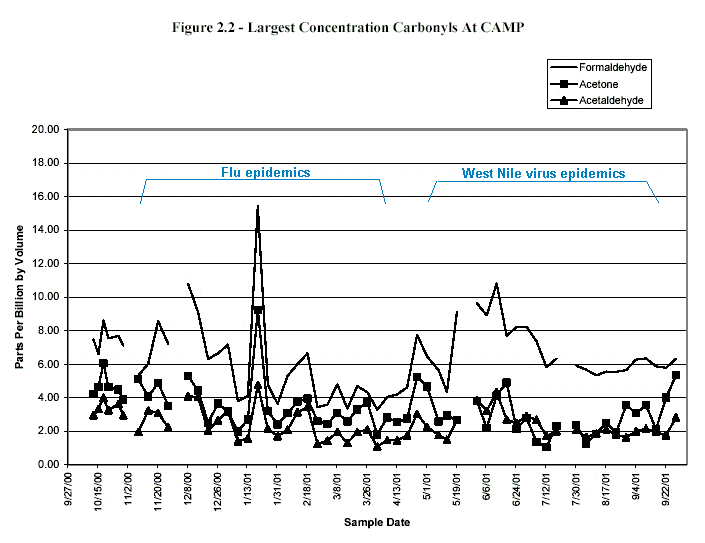
Emission Graphs (Denver), Year 2003
Given a familiarity with the recent flu
epidemics, these graphs of air
pollution make sense because air pollution produces flu
symptoms (http://www.homesafe.com/cosupport/general-symptoms.html):
|
Denver Air Pollution, Carbon
Monoxide Component (Year 2003)
During the Flu Epidemics
|
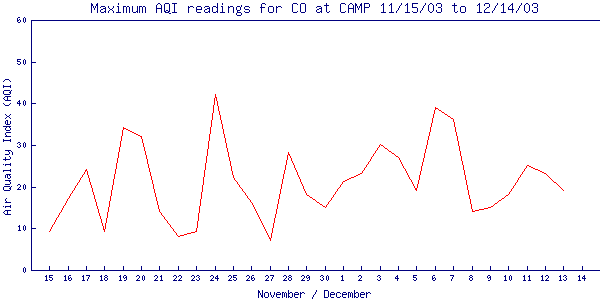 |
|
http://apcd.state.co.us/psi/main.html |
|
Denver Air Pollution, Sulfur
Dioxide Component (Year 2003)
During the Flu Epidemics
|
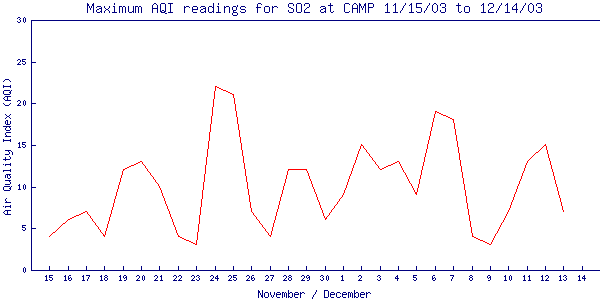 |
|
http://apcd.state.co.us/psi/main.html |
|
Denver Air Pollution, PM10
Component (Year 2003)
During the Flu Epidemics
|
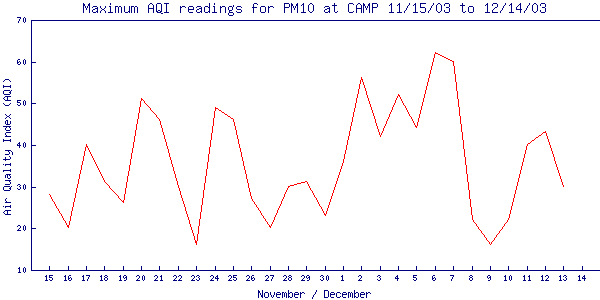 |
|
http://apcd.state.co.us/psi/main.html |
In Colorado, the government agencies issues "red" alerts during high air
pollution. Did they issue "red" alerts during flu incidence
spikes?
That question was actually my first foray into my search for Denver flu
causation: I typed into www.google.com,
keywords related to a major flu spike: "Tuesday, Colorado, red, air pollution, 2003".
Here is the first noted result, a coinciding spike of winter air pollution:
---Mesa, CO---
http://www.co.mesa.co.us/health/environment/airadvisories.htm
A RED air quality advisory is being declared for Monday, December 01
through
3:00 p.m. Tuesday, December 02 for the western Colorado valleys including
the communities of Grand Junction, Delta and Montrose.
From 11/30/03 to 12/2/03, three children died of influenza in the Denver
area.
Mesa is a little to the west of the major epidemic areas (Denver) that I was aware
of, so I then focused on the Denver environment and flu activity:
Denver Region
Dates 11/20 to 11/25 had the highest levels of sulfur dioxide for the
entire year. 11/24 had the fifth highest levels of carbon monoxide.
11/24 and 11/25 had the seventh and eighth highest levels of particulate
matter (PM2.5).
This article published on 11/26, states that 1,100 FLU cases were
reported during 11/24 and the four previous days, representing one third
of all flu cases reported to that date this year. Four children died
in that "outbreak" which coincided with high emission
levels.
www.channel4000.com/sh/health/stories/health-266682520031126-111131.html
Four Children Die In Colorado Flu Outbreak
Posted: 12:28 p.m. EST November 26, 2003
DENVER -- Colorado is dealing with one of its worst flu outbreaks
in years.
The state has had nearly 3,400 confirmed cases of the flu this season.
That includes more than 1,100 cases reported between Thursday and Monday.
Four children have died of flu-related illnesses, three of those at
Children's Hospital in Denver. [...]
Air poison levels peak, children and elderly die, thousands get ill, and
the
only headline is the "flu" and "get vaccinated".
Oil Refineries
The air toxic mystery is usually resolved with a search for "oil
refinery"
and the epidemic township name. Plug these into www.google.com
and up pops
Conoco Oil Refinery and Colorado Refining Company. These appear to
lay within the city of Denver, but technically, they are
out of the city limits (see map).
The epidemic areas mentioned in the news are mostly adjacent the oil refineries. The refineries are nearly
within the city limits of Denver. The official air
pollution alert for polluted winter days is "no burning firewood
outdoors." No mention of industry -- pollution is
blamed on campers and house heating. As in the tri-state region
(NY/NJ/CT), no media
speaks of refinery air pollution; all the news here (NYC) is
absolutely silent on the issue, even when refinery pollution is highly
evident (www.geocities.com/noxot),
or when the city is draped in refinery pollution. The major
environmental groups, such as Audubon Society, are dependent upon strong
funding from the major polluters, and their board of directors are stuffed
with their representatives; that may account for their
reticence. Same goes for the EPA.
---Colorado Flu deaths near refineries---December 5, 2003---
http://www.vietnamvets.com/wwwboard/messages/21581.html
"A 2-year-old and a 4-year-old from suburban Thornton died of the flu this
week, following the deaths last month of children ages 15, 8 and 21
months.
State officials were trying to determine if the death of another
2-year-old
was caused by flu, and officials in Colorado Springs on Wednesday
confirmed
the death of a sixth-grader in Colorado Springs School District 11,
possibly
from the flu."
Five children dying of the "flu". Obviously there is
something
about Thornton. It is near Commerce City..
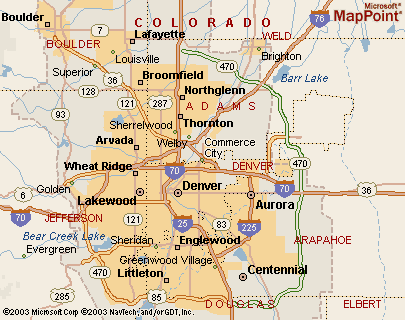
The refineries are in Commerce City. My flu
research focused there merely because of the oil refineries. It was
then found to be a major flu epicenter.
http://www.bizjournals.com/denver/stories/2003/11/03/focus2.html
"Denver's northeast neighbor, Commerce City, is closely associated
with heavy industry, including the oil refineries that dominate the
landscape."
Commerce City is also the
primary West Nile virus epicenter for Colorado, per the following excerpt:
www.rockymountainnews.com/drmn/local/article/0,1299,DRMN_15_2129025,00.html
West Nile cases in 2002
. Sept. 17: Commerce City man is state's first confirmed human case
. Sept. 25: Man from Prowers County and man from Weld County
. Oct. 3: 19-year-old Pueblo woman and an 18-year-old Commerce City man,
son
of Sept. 17 case
. Oct. 28: 42-year-old woman in Commerce City
As stated earlier, much evidence links West Nile virus epidemics
to air pollution.
Denver air pollution is triple any other area in the state on 12/12/03
http://apcd.state.co.us/psi/main.html
Denver Air Pollution: A Different View
http://apcd.state.co.us/psi/main.html,
the Air Pollution Control Division for Colorado, gives us pertinent data.
During the last 346 days (1/1/03 to present), the last three weeks (which
are the flu epidemic weeks) are the worst polluted, vying with
mid-summer levels:
Sulfur
Dioxide (SO2)
Year 2003 |
| Date |
Position, as "Worst"
Day of the Year |
| 11/20/03 |
8th |
| 11/24/03 |
1st |
| 11/25/03 |
2nd |
| 12/02/03 |
7th |
| 12/04/03 |
8th |
| 12/06/03 |
4th |
| 12/07/03 |
5th |
That matches the flu epidemic spikes. So does the next set
of numbers:
Carbon
Monoxide (CO)
Year 2003 |
| Date |
Position, as "Worst"
Day of the Year |
| 11/24/03 |
5th |
| 12/01/03 |
10th |
| 12/03/03 |
10th |
| 12/06/03 |
7th |
| 12/07/03 |
7th |
While not all these toxic dates win the top annual prize; they are among
the highest and are strung together, day after day, pounding
the population of Denver.
Particulate
Matter (PM2.5)
Year 2003 |
| Date |
Position, as "Worst"
Day of the Year |
| 11/24/03 |
7th |
| 11/25/03 |
8th |
| 12/02/03 |
10th |
| 12/06/03 |
5th |
| 12/07/03 |
5th |
| 12/11/03 |
4th |
| 12/12/03 |
3rd |
| 12/13/03 |
8th |
Graphic Summary: Carbon Monoxide ("Camp"
Monitor site, Denver)
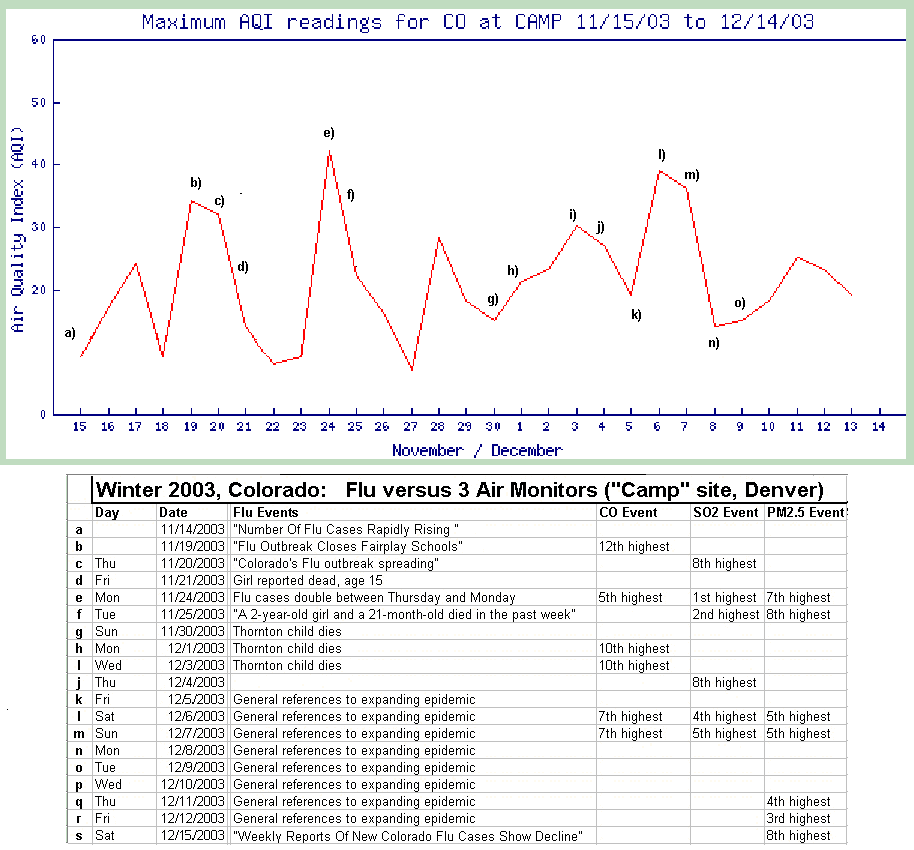
Note re Monitor Events fields above: I had only queried for the top 12
highest levels of the year, so blank fields meaning "not as bad as
12th worst."
Colorado State Department of Health Cases
Versus Three Air Pollution Monitors
This graph might not be the strongest presentation of the air pollution
theory. However, here is an interpretation: Up to, and including
12/3/2003, air pollution and flu morbidity correlate well. A loosely
correlated decline then begins towards 12/15/2003, loosely, because
susceptibles were no longer available after the tremendous spike of 11/24/2003.
Few susceptibles were remaining after 12/3/2003 in the face of continuing
high air pollution. Still lacking is data
for carbonyls (such as formaldehyde), VOCs, and nitrates.
Up To 12/15
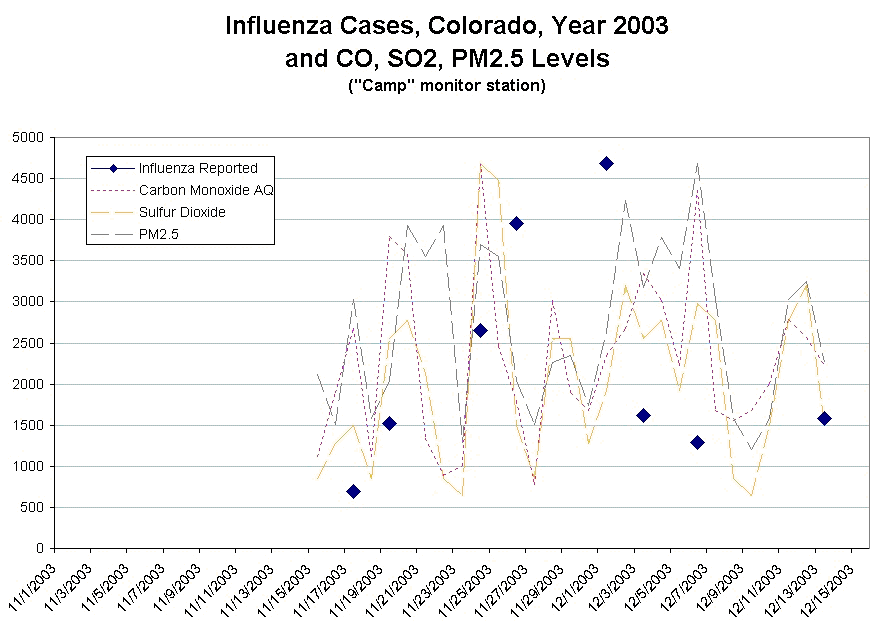
Up To 12/20
A week later. This chart includes polynomial lines (trendlines),
and deaths are marked with circles.
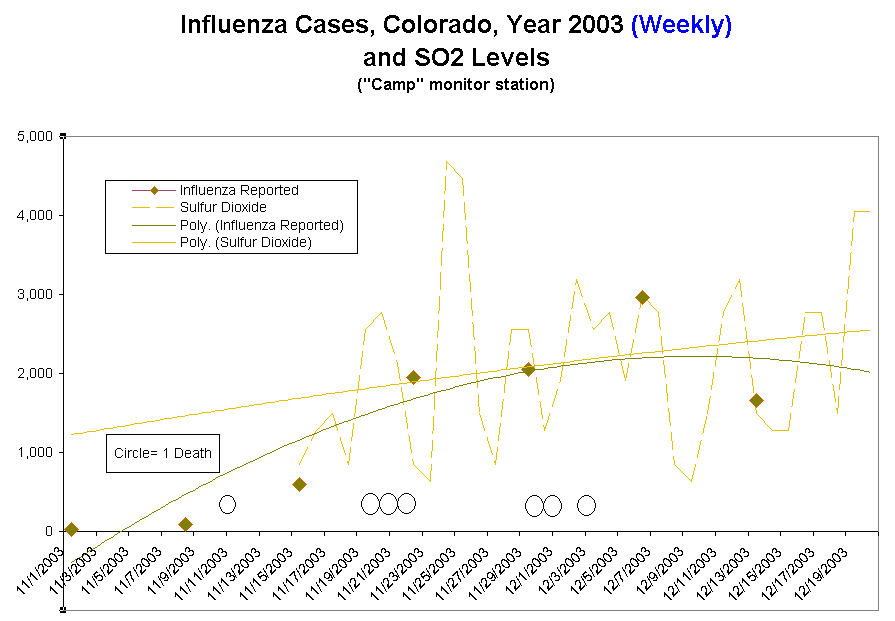
The intent is to update this graph each week for
the next few months. So reader, stay in touch.
Up to 1/4/2003
Decreasing flu and air pollution correlate very well, just
as expected. Charts above not updated here yet.
[Temperature analysis goes here, work in progress]
Conclusion
Air pollution is a subtle, politically hidden killer. Remember the
"great
heat wave" that killed so many people last summer in Europe?
That was
diagnosed by orthodoxy even, to be air pollution, if you read the fine
print:
Source: Reuters [Sep 01, 2003]
"PARIS (Reuters) -- Air pollution may have been the cause of death for
thousands of French people who died in a heatwave that struck Europe this
August, an environmental official said on Monday. [...]"
More related air pollution information:
http://www.disabilitylife.net/Text/Colorado%20Quarterly%20Text/summer2003/colorado_quarterly_text_version.htm
"AIR POLLUTION FATALITIES NOW EXCEED TRAFFIC FATALITIES BY 3 TO 1"
"The World Health Organization reports that 3 million people now die
each
year from the effects of air pollution. This is three times the 1 million
who die each year in automobile accidents. A study published in The Lancet
in 2000 concluded that air pollution in France, Austria, and Switzerland
is
responsible for more than 40,000 deaths annually in those three countries.
About half of these deaths can be traced to air pollution from vehicle
emissions. [...]"
Toxic vaccines
http://www.gov.ns.ca/health/downloads/influenzamyths.pdf
"Less than 2% of recipients of influenza vaccine
will experience flu-like symptoms..."
That orthodox statement depends upon patients' and doctors'
willingness to report symptoms. Doctors don't get paid to fill out the
forms, so what's the incentive. Admission of iatrogenic causation can result in
malpractice lawsuits, loss of time and profit.
There is more data on vaccines as causative for flu
symptoms and the statistics of reporting adverse vaccine reactions. Sheri
Nakken has the data: http://www.nccn.net/~wwithin/vaccine.htm
Personal experience: While in the Army, everyone in my unit
experienced coughing, sputum, "flu", fever, and walking pneumonia
immediately after being subjected to a battery of vaccinations. We
heard of soldiers falling over dead with fever in other units.
The health problems, a brooding fever, constant tiredness and susceptibility
to respiratory problems took years to recover from. Vaccines are loaded with poisons to neutralize and preserve the
"deadly virus" they contain.
Are vaccines effective? The flu "virus" evolves and changes
form rapidly; thus flu vaccines have been described as not effective.
http://www.cdc.gov/mmwr/preview/mmwrhtml/mm5222a2.htm
"CDC has antigenically characterized 626 influenza viruses
submitted by U.S. laboratories since September 29, 2002."
Redefining "Flu"
To know what killed the influenza victims this year, an
environmental analysis should be included in the diagnostics for each child, finding the total
stress burden.
Wind direction, stagnation
Emissions (petrochemical, smelters, powerplants, etc.)
Expressway
Airports
Pharmaceutical history
Vaccination history
Nutritional study
Water study
Health history
As it is, doctors are more interested in who sneezed, forgot to wash their
hands, and vaccination status. Medical diagnostics may be biased
since, studies show that a primary
source of information for MD's is provided by pharmaceutical companies
(med-schools are not considered "pharmaceutical companies" in this assessment).
* * *
Home
Page
* * *
(c) HARpub 2003
All Rights Reserved








